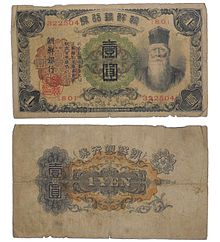Korean yen
This article includes a list of references, related reading, or external links, but its sources remain unclear because it lacks inline citations. (June 2016) |
| Korean yen | |
 1 yen note, 1932 | |
| Korean name | |
|---|---|
| Hangul | 엔 |
| Hanja | 圓 |
| Revised Romanization | en |
| McCune–Reischauer | en |

The Korean yen was the currency of Korea between 1910 and 1945. It was equivalent to the Japanese yen and consisted of Japanese currency and banknotes issued specifically for Korea. The yen was subdivided into 100 sen. It replaced the Korean won at par and was replaced by the South Korean won and the North Korean won at par.
Banknotes
From 1902-1910, banknotes were issued by Dai Ichi Ginko (First National Bank of Japan, 株式會社第一銀行, Kabushiki Gaisha Daiichi Ginkō). Denominations included 10 sen, 20 sen, 50 sen, 1 yen, 5 yen, and 10 yen. The sen notes were vertical and resembled the Japanese sen notes of 1872 and the Japanese military yen at the turn of the century. These notes were redeemable in "Japanese Currency at any of its Branches in Korea"
In 1909, the Bank of Korea (1909) (韓國銀行) was founded in Seoul as a central bank and began issuing currency of modern type. Bank of Korea notes were dated 1909 and issued in 1910 and 1911. After Korea lost sovereignty to Japan in 1910, the Bank of Korea was renamed the Bank of Chosen (朝鮮銀行, Korean: Joseon Eunhaeng, Japanese: Chōsen Ginkō). The first Bank of Chosen note was dated 1911 and issued in 1914. 1 yen, 5 yen, 10 yen, and 100 yen were issued regularly, while there were occasionally some sen notes (5, 10, 20, 50 sen). 1000 yen was printed but never issued at the end of World War II. The earlier issues were redeemable "in Gold or Nippon Ginko Note". A similar phrase was written in Japanese on later issues.
See also
References
- Schuler, Kurt. "Tables of Modern Monetary History: Asia".
- Pick, Albert (1996). Standard Catalog of World Paper Money: General Issues to 1960. Colin R. Bruce II and Neil Shafer (editors) (8th ed.). Krause Publications. ISBN 0-87341-469-1.
| Preceded by: Korean yang Reason: heavier influence by Japan Ratio: 1 yen = 5 yang |
Currency of Korea of Empire of Japan 1902 – 1945 Concurrent with: Korean won until 1910, when Japan completely annexed Korea |
Succeeded by: North Korean (old) won Reason: end of World War II and Division of Korea |
| Succeeded by: South Korean (old) won Reason: end of World War II and Division of Korea Ratio: at par |
